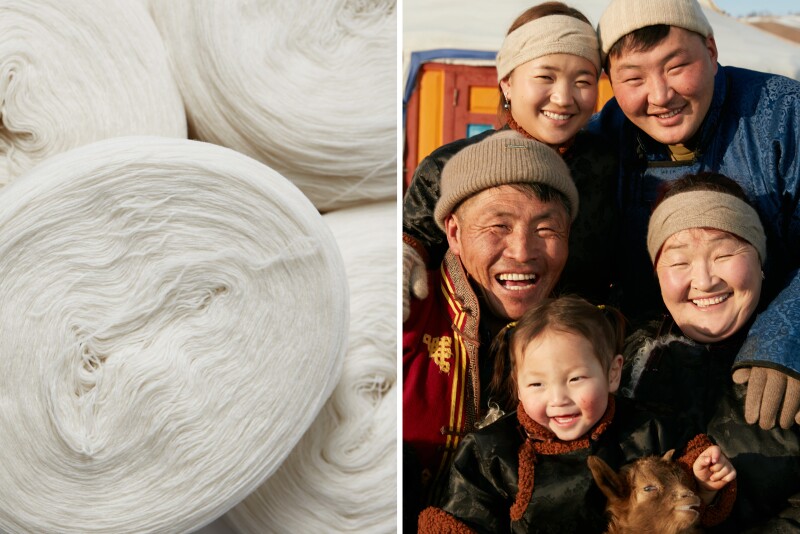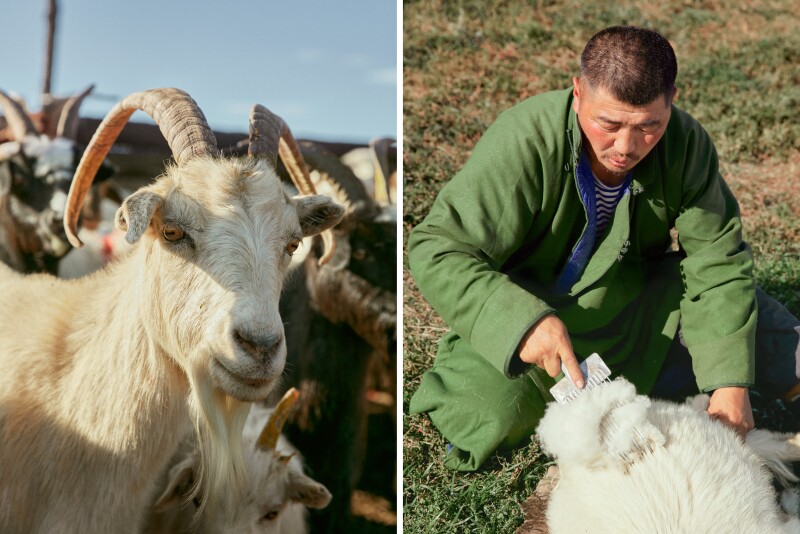Mongolia gets cold. Really, really cold. In the depths of winter, temperatures can drop as low as –40° (which, someone is bound to cheerily inform you, is the same in Celsius and Fahrenheit). It wasn’t nearly that frigid as I walked around the capital city of Ulaanbaatar on a bright October morning, but my fingers and ears were already feeling icy through my thin gloves and ill-fitting hat. In a few days, I’d be heading to the harsh winds of the open steppe and early snows of the mountain valleys—and if I was cold now, I’d be in bad shape then. Mentioning my predicament to my tour guides and a few new local friends I’d made, I kept hearing the same advice: Go to Gobi Cashmere.
Founded in 1981 as a government-owned entity and privately owned since 2007, Gobi crafts its clothing and accessories entirely in Mongolia from 100 percent Mongolian cashmere. Since the country’s communist era, which lasted from 1924 to 1990, the fabric has been tied to the national economy. What’s more, cashmere has been an agricultural staple of nomadic farmers for generations. The super soft wool—combed from the undercoat of goats that thrive in Mongolia’s plains, mountains, and forests—is among the country’s top exports along with minerals such as copper and gold. Only China produces more cashmere.
Today, Mongolia is home to about 27 million cashmere goats—more than eight times the number of humans. That has created some issues: The voracious goats, coupled with rising temperatures and climate change, are contributing to the desertification of Mongolia’s grasslands.

Mongolia’s nomadic herders have tended cashmere goats for thousands of years. The material is one of the country’s top exports.
Courtesy of Gobi Cashmere
At the same time, Mongolian cashmere has garnered international attention in the fashion world. Vogue and Forbes have given shout-outs to Gobi Cashmere, and it’s been worn by such celebrities as comedian and actress Robin Thede. As its star rises, Gobi hopes to bridge the gap between honoring the country’s ancient cashmere tradition while responsibly ushering it into a more sustainable future.
International shoppers are getting to know the brand too: Gobi launched a U.S. e-commerce site in 2019, ran a pop-up shop in Manhattan this past winter, has a brick-and-mortar store in Berlin, and says it is prepping to open more shops in the U.S. and U.K. Its flagship store is a two-story, glass-walled jewel box in the center of Ulaanbaatar, steps from the Parliament building. Walking through its doors on that cold October day, I wanted to wrap myself in the rainbow of items on the shelves, all made in the nearby factory. Gobi’s final products can be as varied as a classic ecru beanie and scarf set, a mod-inspired coat embellished with a pop of neon pink, or a brightly striped dress influenced by international designs—the bold spring/summer 2023 collection was inspired by Mexican architecture. But they all start in the fields with the goats and their caretakers.
“Nomadic herders have grazed cashmere goats on Mongolia’s rangelands for thousands of years,” says Ivgeel Erdenebat, head of the Sustainable Development Division of Gobi Cashmere. “The goats, along with horses, camels, yaks, and sheep, provide livelihood, food, warmth, and mobility. Cashmere from goats and wool from sheep are pressed into felt to make clothes, bedding, and shelter; their hairs and bones make musical instruments and toys; and even their dried dung is used as fuel for fires to make food and to warm up their homes.”

Mongolia’s nomadic herders have tended cashmere goats for thousands of years. The material is one of the country’s top exports.
Courtesy of Gobi Cashmere
To showcase herders and their nomadic tradition, Gobi puts an emphasis on traceability: It sources its cashmere from nearly 3,000 herding families living across Mongolia. Shoppers can read about the origins of Gobi’s cashmere on the company’s website, as well as learn about the herders’ lives. “Mongolian nomadic herders make it their main mission in life to take care of their livestock,” says herder Purevdorj Zamind, who inherited his animals from his parents about 25 years ago. Zamind has worked with Gobi since October 2020 and is part of a company partnership between local herders and a team from the Mongolian University of Life Sciences. Together, they combine nomadic practices and scientific studies to improve the well-being of the animals and the workload of herders. The idea is that healthier goats will produce higher-quality cashmere, and more of it, enabling herders to keep smaller flocks and use less land, while maintaining their income. Gobi Cashmere is also conscientious about how it sources raw cashmere, deferring to nomadic tradition and rhythms.
As its star rises, Gobi hopes to bridge the gap between honoring the country’s ancient cashmere tradition while responsibly ushering it into a more sustainable future.
“As the weather gets warmer, the animals’ undercoat [the cashmere] naturally comes loose and sheds,” says Zamind, who hand-combs his goats—a point of pride for Gobi. All of its cashmere is hand-combed, which is thought to be less stressful for the animals than mechanical shearing because it is gentler, can be timed to the goats’ natural shedding cycle, and leaves their protective overcoat intact. “It also massages the goat,” Zamind adds.

From left: A herdsman hand-combs a cashmere goat; Gobi’s Organic Collection reflects the goats’ natural colors.
Courtesy of Gobi Cashmere
Once the raw material is collected by the herders, garment workers at Gobi’s factory in Ulaanbaatar transform it into cozy clothing and accessories. Their first step is to wash the wool and to remove any impurities or coarse hairs. Machines then sort it by width, quality, and its four natural colors—white, dark gray, beige, and blue/gray. White goats are usually found in the Gobi Desert, dark gray in the mountains and forest steppes, beige in the desert and steppe regions, and blue/gray (the rarest variety) are typically found in western Mongolia.
At this point, some of the fibers get a dose of dye (from plant extracts and minerals when possible—all are certified to meet the international “bluesign” sustainability standards). But other fibers remain undyed, reflecting the wool’s four natural colors. They appear in the brand’s Organic Collection, which reduces water, energy, and chemical usage by skipping the dyeing step.

Gobi Cashmere weaves nomadic herding practices into their modern, sustainably-minded business model.
Courtesy of Gobi Cashmere
Spinning machines—carefully maintained by mechanics such as Byambadorj D., who, at 40 years with the company, is Gobi’s longest-serving employee—then spin the fibers into yarn, which is woven or knitted depending on the kind of product it’s intended for. Next, staffers cut and sew the material into its final form, whether it be a coat, sweater, blanket, baby sock, or blazer.
In its evolution, Gobi has worked on ways to minimize its environmental impact. The company has partnered with ecoprotective projects including the Sustainable Fibre Alliance (a U.K.-Mongolian nonprofit), and adheres to textile production standards jointly set forth by an E.U.-Mongolian initiative. It also repurposes waste material from the production process into the CashmeREborn collection of sweaters, which launched in 2022. Gobi says the label uses 13 percent less water, 16 percent fewer chemicals, and 31 percent less energy than what’s needed to manufacture new yarn. It says the Organic Collection lowers water and energy consumption and carbon outputs by 20 percent each too.
When I returned to the store at the end of my trip to load up on presents for my friends and relatives back home in New York, I felt drawn to the organic colors—a direct reminder of the families who welcomed me so warmly on the steppe. I left with an armful of earth-toned scarves, hats, and sweaters, and a naturally beige blanket for myself. Wrapped in it now, I think of herder Zamind’s words: “The hard work of herders and the value of natural raw materials are what lie behind all of this.”











